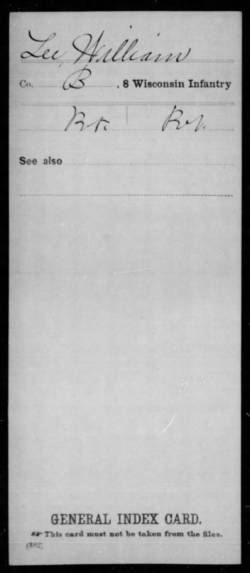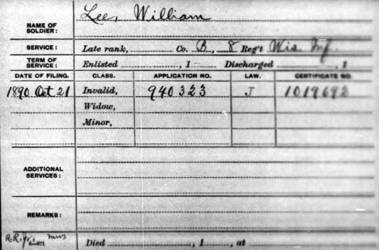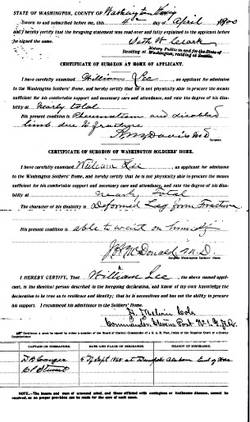William Lee
Representing: Union
G.A.R Post
- Isaac Stevens Post #1 Seattle, King Co. WA
Unit History
- 8th Wisconsin Infantry B
Full Unit History
8th WISCONSIN VOLUNTEER INFANTRY
Organized: September, 1861 Camp Randall Madison, WI
Mustered In: 9/13/61 Camp Randall Madison, WI
Mustered Out: 9/5/65 Demopolis, AL
Regimental History
REGIMENTAL HISTORY:
The 8th was a three year western theater unit also known as the "Eagle Regiment." It left the state of Wisconsin on 10/12/61 en- route to the lower Mississippi.
Mississippi actions which followed included Greenville, Island No. 10, Farmington, Corinth, Iuka, Henderson's Hill, Pleasant Hill, Cloutierville, Bayou Lamourie, Atchafalaya River, Lake Chicot Jackson, Hayne's Bluff and Vicksburg. The unit was also engaged with the enemy at Richmond, LA and Nashville, TN.
The commanding general at Farmington said in general orders: "The Badger State may feel proud to have the honor of being represented by so gallant a regiment as the 8th Wisconsin."
Union Gen. William T. Sherman highly complimented the 8th for doing "its whole duty in camp, on the march and in battle." He also commended them for "peculiar courage and gallantry at Jackson, throughout the siege of Vicksburg" and for other services.
REGIMENTAL LOSSES:
Officers Killed Or Mortally Wounded: 6; Officers Died Of Disease, Accidents, Etc.: 2; Enlisted Men Killed Or Mortally Wounded: 53; Enlisted Men Died Of Disease, Accidents, Etc.: 219.
Soldier History
SOLDIER:
Residence: Otsego, WI Age: 21.1 yrs.
Enlisted/Enrolled: 9/18/61 Camp Randall Madison, WI Rank: Pvt.
Mustered In: 9/18/61 Camp Randall Madison, WI
Mustered Out: 9/5/65 Demopolis, AL
Highest Rank: Pvt.
Rank At Discharge: Pvt.
Family History
PERSONAL/FAMILY HISTORY:
William Lee was born 8/12/1838 Canada likely in Canada West (Calgary Alberta, Canada). All that is known about his parents is that his father was born in New York and his mother in Canada. There is no available information pertaining to older or younger siblings.
According to William, he came to America with his parents in 1843. At some point he became a naturalized U.S. citizen.
In 1861 William was farming in Otsego, WI. On 9/18 of that year he left the farm and enlisted in the U.S. Army. His unit was Captain Conger's Company of the 8th Wisconsin Volunteer Infantry. That organization subsequently became Company "B" within the 8th.
Private Lee's period of military service proved to be, for the most part benign. For some unexplained reason in October, 1862 he was discharged for re-enlistment. After that he was present at all times except during his 1864 mid-year thirty day veteran volunteer re-enlistment furlough. (For re-enlisting he received a $402 bonus or "bounty", a portion of which was paid up front with the balance to come in later increments)
At his re-enlistment we gain our first glimpse of William Lee the physical being. He was 5'8" tall, had dark eyes, brown hair and a dark complexion.
Having returned to the field from furlough Private Lee served a period of detached duty with a divisional wagon train. Then, in July/August, 1865 - after the shooting war had ended - he was absent without leave (A.W.O.L.) for a time, but returned to his unit.
Private Lee's in-service medical record also proved to be minor. On 1/1/64 he was treated for a boil. He returned to duty on 1/2. Later that same year, on 10/25 he was treated for Pharyngitis which is inflammation of the Pharynx, which is in the back of the throat. On this occasion he returned to duty on 10/27.
In September, 1865 Private Lee settled financial accounts with Uncle Sam. He then returned to civilian life.
Dropping back a bit, here it should be pointed out that in mid-1864 while on his thirty day veteran re-enlistment furlough Private Lee had, on 6/29/64 in Dodge Co., WI, married. His bride was Rebecca Snowder (b. 1847 - '48 England).
Returning from The War, it appears the Lees set up house in Minnesota. That household may have already contained one child, son Frank E. or L. Lee. Although William would later claim Frank's birth occurred on 8/16/66 in Nicollet Co., MN, Frank would say he had been birthed on 8/16/65 in Beaver Dam, Dodge Co., WI.
It appears the Lees remained in Minnesota for about one year before in, 1866, moving to Wausau Marathon Co., WI. It was there on 1/19/69 daughter Dora Ann/Lynn was born.
The U.S. Census tally for 1870 found the Lees in Wausau, WI with children Frank and Dora. Also in the home was a male identified only as George (age 20 b. Canada). George may or may not have been a brother to William. Another male named Barney Lee (age 24 b. Ireland) who was a farm laborer, was also in the home. His possible relationship to the family is unclear. As for William, in 1870 he listed his occupation as "lumberman."
On 6/2/71, in Wisconsin, the Lee's third child, daughter Letta was born. Son William was birthed 3/24/73 in Wisconsin.
Circa 1873 William's life tale becomes murky. There are indications that the family moved from Wisconsin to Nebraska where homestead and timber claims were filed. Likely, too, it was there that sometime in 1878 William and Rebecca divorced.
The divorce and loss of his family appears to have pushed William in the direction of living the life of a recluse and wanderer. He would later say that in 1879 he moved to the Black Hills region of the Dakotas. There he lived the life of a hunter and trapper. The closest civilization was 80 miles away and he would only go into town once a year in order to sell his hides and furs and obtain supplies. Emphasizing that this was the only time of year he would have access to whiskey leads one to speculate that alcohol may well have had something to do with the family disintegration.
As for Rebecca and the Lee children, the U.S. census for 1880 found her Dora, Letty and William back in Beaver Dam Dodge Co., WI. Interestingly, at the time she reportedly her marital status as "widowed."
In later years William would relate the following tale. "In November, 1882 my son, Frank and I were hunting buffalo in the Dakotas. I shot a bull. I thought I had killed it, but when I approached it and placed my knee upon its neck in preparation to reach over and stick it with my knife, the animal threw its head up and backward. I was in a gulch where I could not get away from the wounded animal. The bull caught me about the hips with his horns and threw me up in the air. When I came down I landed in such a way that my right leg was broken (in two placed) between the ankle and the knee. The bone came through the flesh and stuck into the ground with his right foot underneath me.
My son came to my rescue and killed the buffalo. He then helped me to get into as comfortable a position as possible before going back two miles to get our wagon and team. By the time Frank got back I was so cold and numb that I could not get into the wagon. That coldness also lead to long term lung problems.
There was another hunter in our camp who said he could set my leg as it was one hundred miles to the nearest medical care. I remained under that man's care for about a month then went to the hospital at Deadwood, South Dakota. I was in the hospital there for about fifteen months."
When I got out of the hospital in the spring of '84 William began roaming. His first stop was the Powder River area of Wyoming where he took care of a cattle camp until that fall. He then remained in various Wyoming cattle camps until the spring of 1886 when he moved to Sitka, AK. While there (this may have been 1890 - '92) he built a water wheel powered sawmill for the Alaskan natives.
In the spring of 1887 William departed Alaska and moved southward to Seattle, WT. From there, that fall, he moved to the mountainous region of Oregon's Santa Ana River. After remaining there for six months he moved to Vancouver, WT and, from there to Juneau, AT where he remained until the fall of 1890.
On 10/6/90 while in Alaska William began the paperwork processing in an attempt to obtain a U.S. Government disability pension stipend based not only on his period of Civil War soldiering, but his 1882 leg break and general debility. About this same time he also removed from Juneau to Sitka.
William would remain in Sitka from June, 1892 until the fall of 1894. At that time he moved to Alaska's Chignik Bay. He remained there until the fall of 1894 when he removed southward to San Francisco, CA.
In March, 1895 William left California and returned to Alaska, settling in the area of Cook's Inlet. That locational stay lasted only until June, 1898 when he returned back to Seattle. The following year, in Seattle, he noted his address as being 2211 Yesler Way.
1900. Dawn of a new century. A new decade. A new census tally. That year found William residing - as a widower inmate - of the Washington State Soldiers' Home located in Orting Pierce Co., WA.
A 1/28/03 medical exam conducted at Orting noted that the sixty three year old laborer , then collecting a $10 per month pension stipend, weighed 245 pounds, had a chronic cough and catarrh (infection), an enlarged prostate and an "obese" belly.
By the end of 1905 William's pension had increased to $12 per month. He received his last payment on 12/04/05.
William Lee died on 2/19/06. Where he was residing at the time of his passing is not presently known. His burial was/is not in Orting, but in Sunnyside Cemetery located near Coupeville in Island County, WA. How and why that is his final resting place is not known.
As a final footnote, on 3/15/35 son Frank Lee petitioned the U.S. Government in an attempt to obtain an old age pension for himself based on his late father's period of Civil War service. The request was denied.
Cemetery
Buried at Sunnyside Cemetery
Site: Lot 33 Space F





